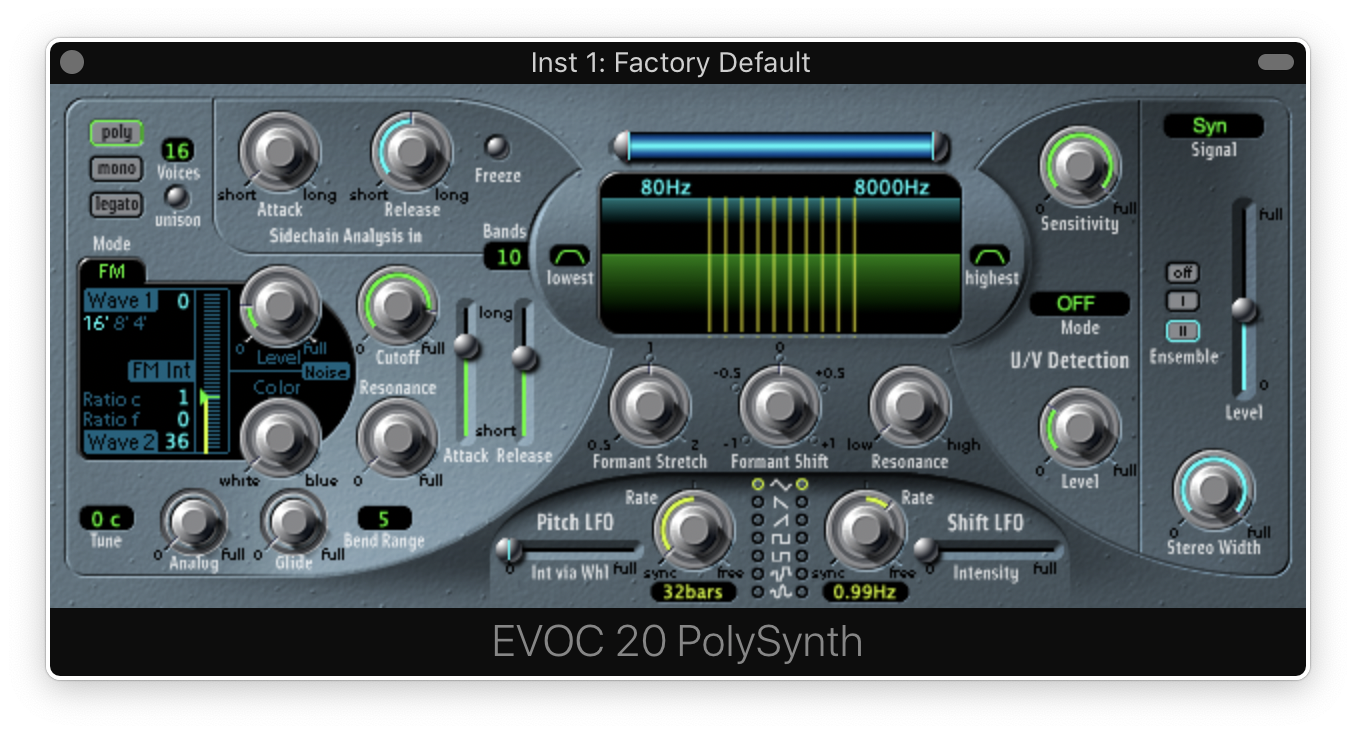Although they were originally developed in the 1920s for communications purposes, the vocoder found a niche within electronic music as an instrument for creating “robotic” vocal sounds.
In modern popular music, vocoded sounds remain as popular as ever. For example, you’ve heard their lush textures on smash hits including Zedd, Maren Morris, and Grey’s “The Middle” and Ginuwine’s “Pony.” But despite their intuitively appealing sound, it can be difficult to understand exactly how a vocoder modifies your audio. In this article, we’ll take a look at what exactly a vocoder really is, and how it works on the audio processing level. We’ll then apply this knowledge in the DAW to explore how we can use some common vocoder parameters to their fullest.
Let’s dive in!
What is a vocoder?
As alluded to above, a vocoder is a type of speech coding technique (or the hardware that applies it) that was originally developed a century ago for telecommunication purposes. By synthesizing human speech into a codec, Homer Dudley of Bell Labs enabled phone conversations to occur over longer distances by preserving precious bandwidth.
How a vocoder works
Vocoders require two audio sources to function: a carrier, which acts as the initial sound source, and a modulator, whose harmonic characteristics shape the sound of the carrier. This is achieved through the use of a “filter bank,” which analyzes the modulator signal, divides it into frequency bands, and applies a band-pass filter to each one. The filters are tuned automatically to the center frequency of each band present in the modulator signal. Finally, once the carrier signal is sent through the filters, the vocoder raises or lowers the level of each filter according to the harmonics of the modulator signal.
…Got all that? Carrier and modulator signals can admittedly be quite difficult to grasp on an abstract level. If the above description didn’t quite process for you, think about how the sound of your voice works for a simplified analogy. Your lungs produce air, vibrating your vocal cords; this is a carrier signal of sorts. Next, the rest of your vocal tract shapes the vibrating air as it leaves your body; you can think of this as a modulator. A vocoder works in the same way, by affecting the carrier signal according to the characteristics of the modulator signal.
What kinds of signals can I use?
Any type of audio signal can be used as either a carrier or modulator (or both simultaneously), but music producers typically use synthesized sounds as carriers and vocals as modulators. For a classic example of a vocoder effect using a saw wave patch as a carrier and a spoken human voice as the modulator, listen to 1:16 of Kraftwerk’s “Trans-Europe Express.”
For a demonstration of a more scratchy, experimental vocoder effect, check out our recreation of Kavinsky’s “Nightcall.” This VocalSynth 2 patch consists of two square waves playing chords and some white noise that serves as the carrier, which is modulated by a spoken vocal part.
These days, plugins like iZotope’s VocalSynth 2 allow music creators to experiment with vocoding, even if they don’t own any fancy hardware. While not as polished as the best third-party offerings, some DAWs like Logic Pro X even have native vocoder plugins that you can play around with.

How to use vocoders in music production
To get high-quality results from your experimentation with vocoders, you’ll probably want to use a carrier wave that’s rich in harmonic content. If you provide the vocoder with more harmonics, the modulation effects will be much more evident and intelligible than, say, a sine or triangle wave. We’d recommend beginning with a saw wave or saw-based synth patch. It’s also not a bad idea to compress or saturate your carrier signal on its way into the vocoder; a more limited dynamic range will help accentuate the effects of the filter bank.
Now let’s talk about the modulator. When you’re singing or talking with the intention of applying a vocoder effect, don’t be afraid to over-articulate. Pronounce the words more clearly than you usually would—since the harmonic characteristics of your voice will be very different, your diction is key to an intelligible vocoder effect (assuming that’s what you’re going for).
On the other hand, pitch accuracy doesn’t really matter when singing into a vocoder. So, focus on making the other characteristics of your voice as interesting as possible.
What are the parameters of a vocoder plugin?
Below are a few parameters commonly found on vocoder plugins and hardware that can help guide your creative process.
Bands
This refers to the number of frequency bands into which the modulator signal is split. Essentially, you can think of this as resolution. Vintage vocoders tended to have fewer frequency bands, so try using a setting of 8 – 12 bands if you’re going for a more classic sound.
Frequency range
This refers to the upper and lower limits of the frequency in the carrier signal accepted by the vocoder. To increase intelligibility, try raising the upper limit of the frequency range on your vocoder above ~5 kHz.
Formant
Some vocoders offer a formant parameter (sometimes also referred to as “shift”). This will increase or decrease the frequencies of the filters. In turn, this makes the result sound brighter or deeper, respectively.
Manipulating your vocoder’s formant parameter is great for blurring the lines or switching between ‘male-sounding’ and ‘female-sounding’ vocals. In fact, some vocoders even have a “gender” parameter dedicated to this!
Unvoiced
Unvoiced sounds occur naturally in human speech. Also known as plosives, these sounds are produced when we make a consonant that requires blowing air through the lips (such as “p” or “b”).
Many vocoder plugins are capable of detecting these airy, noisy sounds, which span a distinct frequency range from pitched, vibrating vocal cord sounds. For example, on Ableton’s Vocoder audio effect, the Unvoiced knob allows the user to mix a noise generator with the carrier wave to ensure that these un-pitched transient sounds remain present in your vocoded audio.

Conclusion: What is a vocoder?
Whether you’re shooting for a classic synth pop sound or designing cinematic robot vocalizations for a sci-fi film, vocoding is a versatile technique that can meet an array of creative needs. We hope this article was helpful in giving you some insight into the history of vocoders, how they work, and how you can apply them in your own music.
Do you have any questions on how to use vocoders? Are there any vocoder tricks that you rely on in your own productions that you’d like to share? Join our Discord community and start a conversation with other music creators who are looking to exchange knowledge and advance their craft.
Dive into the world of vocoding with iZotope’s VocalSynth 2:
April 26, 2022



